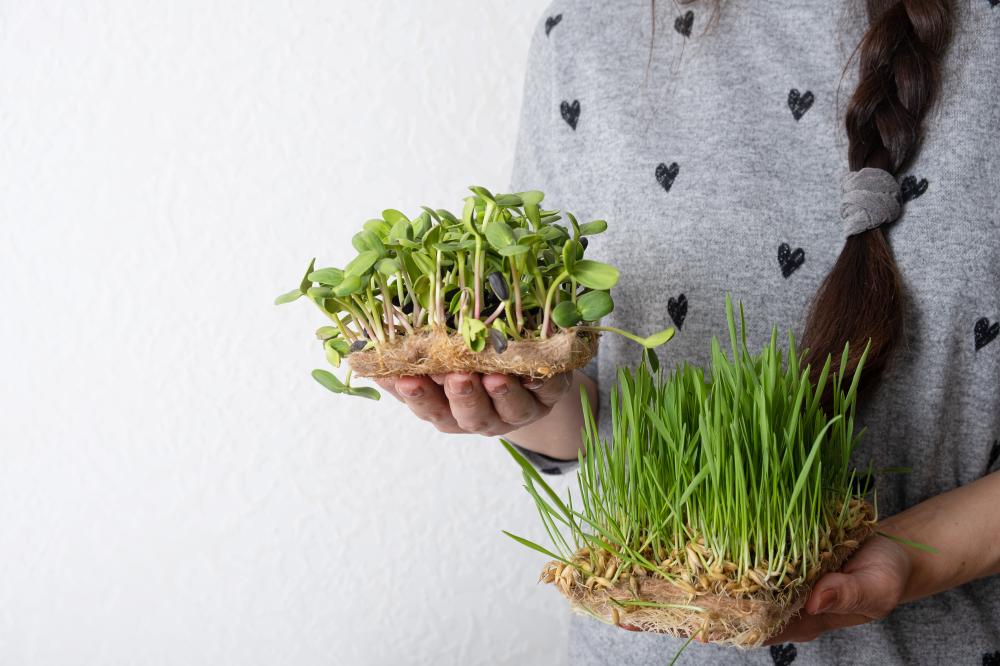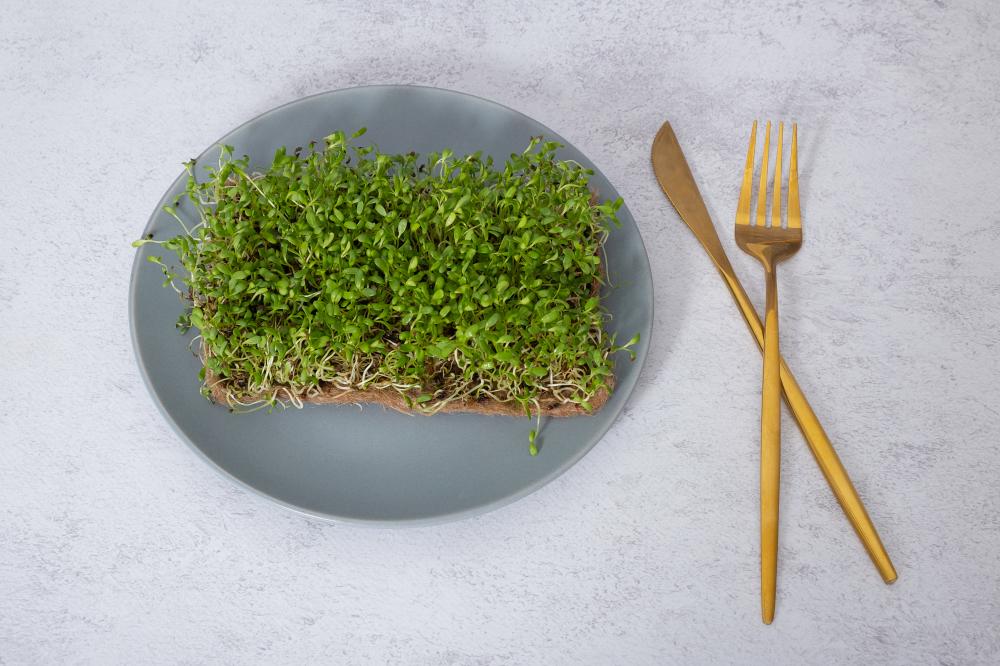
Introduction to Microgreen Benefits
At RightFit Gardens, we’ve always believed that gardening enriches lives, not just through the beauty of plants but also through the nutritional power they offer. For those of us dedicated to a greener world, microgreens are somewhat of a marvel. These tiny plants pack a hefty nutritional punch, and exploring the microgreen benefits can enlighten us on how to incorporate them into our diets for enhanced health and well-being.
What Are Microgreens?
Before diving into the specifics, it’s crucial to understand what microgreens are. They’re young vegetable greens, harvested just after the first true leaves have developed. Unlike sprouts, which are grown in water and harvested within days, microgreens are grown in soil or hydroponic systems and are typically harvested 1-3 weeks after germination. The varieties are endless, with popular ones including radish, broccoli, kale, and arugula, each offering its unique flavor and a cocktail of nutritional benefits.
Nutritional Profile
The Science Behind the Nutrients
Microgreens are not just about their diminutive size; they’re a powerhouse of vitamins, minerals, and antioxidants. Research suggests microgreens can contain up to 40 times more nutrients than their mature counterparts. Imagine consuming a small handful of radish microgreens and getting a day’s worth of vitamin C and E. That’s the kind of nutritional density we’re talking about.
Key Nutrients in Microgreens
- Vitamins A, C, E, and K
- Calcium, Magnesium, Phosphorus, and Iron
- Antioxidants such as polyphenols
8 Core Microgreen Benefits
1. Antioxidant Powerhouse
One of the standout microgreen benefits is their high antioxidant content. These compounds are vital in fighting off free radicals, which are known contributors to various chronic diseases. Incorporating microgreens into your diet can bolster your body’s defense against heart disease, cancer, and even Alzheimer’s.
2. Enhanced Nutrient Intake
With their nutrient-dense profile, microgreens are a simple way to increase your vitamin and mineral intake without having to consume large quantities of vegetables. This is particularly beneficial in today’s fast-paced world where getting adequate nutrients in our diet is a constant challenge.
3. Immune System Support
A strong immune system is your body’s first line of defense against infections. Microgreens, with their rich vitamin and mineral content, play a crucial role in bolstering your immune system, keeping you healthier and more resilient against common illnesses.
4. Potential in Chronic Disease Management
Emerging research indicates that microgreens could play a role in managing and potentially reducing the risk of chronic diseases, thanks to their high antioxidant and nutrient content. While more research is needed, the current findings are promising.
Incorporating Microgreens into Your Diet
Making microgreens a part of your daily meals is easier than one might think. Their versatility in the kitchen is unmatched. Sprinkle them over salads for a nutrient boost, blend them into smoothies for a vibrant green color and a healthful kick, or use them as garnish on soups and pizzas for added texture and flavor. The possibilities are as limitless as your creativity in the kitchen.
Growing Microgreens at Home
Growing microgreens is a fulfilling venture that can make their health benefits even more accessible. All you need is a small tray, quality soil, seeds, and some water. It’s a perfect project for urban dwellers with limited space or anyone looking to start a small, manageable garden. Plus, growing your microgreens ensures you have the freshest, most nutrient-dense harvest possible, free from pesticides and harmful chemicals.
At RightFit Gardens, we encourage gardeners of all levels to experiment with growing microgreens. For those interested in hydroponics, microgreens are an excellent starting point. They adapt well to hydroponic systems, and with our range of resources and articles, we’re here to guide you every step of the way.
Sustainability and Microgreens
Growing microgreens not only benefits your health but also the planet. They require very little water compared to traditional crops, and their short growth cycle means you can produce more in less space. This makes microgreen cultivation a sustainable practice that aligns with our mission at RightFit Gardens to promote gardening practices that contribute to a healthier planet.
A Step Towards a Healthier World
At RightFit Gardens, we view gardening as a foundational element of a healthy, happy world. Microgreens, with their myriad of health benefits, offer a powerful way to enhance our daily nutrition, support the environment, and even provide a gratifying gardening experience. By including microgreens in our diets and encouraging the growth of these nutritional dynamos, we take steps towards better health and a more sustainable world. Connect with us today, and let’s grow together in creating greener, more flourishing spaces.
Frequently Asked Questions About Microgreen Benefits
Are microgreens a superfood?
While the term “superfood” isn’t scientifically defined, microgreens certainly fit the profile given their dense nutrient content and health benefits. Including them in your diet can be a game-changer for your health.
Can you eat microgreens every day?
Absolutely! Incorporating microgreens into your daily diet is a fantastic way to boost your intake of essential nutrients. Just remember, a balanced diet is key, so make sure to consume a variety of foods alongside microgreens for optimal health.

Is it good to eat microgreens everyday?
Absolutely! Eating microgreens every day is not only safe, it’s a fantastic way to enhance your daily nutrient intake. Here at RightFit Gardens, we like to think of microgreens as nature’s multivitamin. They’re packed with essential vitamins, minerals, and antioxidants that support overall health. However, it’s important to remember diversity in your diet is key. While microgreens are nutrient-dense, incorporating a variety of fruits, vegetables, and other whole foods alongside microgreens ensures you’re getting a well-rounded intake of nutrients. Have you tried adding microgreens to different meals to see how they can complement your diet in flavor and nutrition?
Are microgreens a superfood?
While the term “superfood” isn’t officially defined in the nutritional world, microgreens certainly fit the bill for what many consider a superfood. They boast a concentrated amount of vitamins, minerals, and antioxidants in just a small serving. What makes microgreens stand out at RightFit Gardens is not just their nutrient content, but their versatility and how they inspire us to incorporate more greens into our meals in innovative ways. Whether it’s adding them to smoothies, salads, or sandwiches, microgreens are a super addition to any diet. How will you add these nutrient-packed greens into your next meal?
What is the healthiest microgreen to eat?
Choosing the healthiest microgreen is a bit like trying to pick the best star in the sky–they all shine brightly with benefits. However, if we were to highlight one, broccoli microgreens often come up in conversations for their health-promoting properties. They are particularly rich in sulforaphane, a compound noted for its anti-cancer potential. Each microgreen variety, though, has its unique nutritional profile. At RightFit Gardens, we encourage exploring a variety of microgreens to enjoy a spectrum of flavors and health benefits. Have you discovered a personal favorite microgreen yet?
Are microgreens healthier than regular vegetables?
When we talk about microgreens versus mature vegetables, it’s not so much a competition as it is a complement. Microgreens can contain higher concentrations of nutrients compared to their mature counterparts. This means you can get more nutritional bang for your buck with a smaller amount of product. That being said, mature vegetables have their own benefits, including fiber and a full day’s worth of certain vitamins and minerals that are equally important for a healthy diet. The key is variety. Including both microgreens and mature vegetables in your diet offers the best of both worlds. How do you balance incorporating both into your diet for optimal health?
How can I start incorporating microgreens into my meals?
Starting to incorporate microgreens into your meals is as easy as it is exciting! At RightFit Gardens, we love experimenting with microgreens in all sorts of dishes. Start simple by sprinkling them over your salads or soups for a nutritious kick and a splash of color. As you become more familiar with their flavors, you can get creative by adding them to smoothies, sandwiches, and even as pizza toppings. The beauty of microgreens is their versatility–they can enhance almost any dish without overwhelming it. Have you thought about what your first microgreen-infused dish will be?
Can I easily grow microgreens at home?
Yes, you certainly can, and it’s easier than you might think! Growing microgreens at home is a rewarding and simple endeavor. You need a shallow tray, quality soil, seeds, and some water. These little greens are not only a powerhouse of nutrition but also require minimal space, making them perfect for urban dwellers or those with limited gardening space. At RightFit Gardens, we’re passionate about helping you get started on your microgreen journey. Watching your greens sprout and flourish is a truly gratifying experience. Are you ready to give it a try and enjoy the freshest microgreens at your fingertips?
Resources
- ChooseMyPlate.gov – ChooseMyPlate is a resource provided by the U.S. Department of Agriculture that offers information on healthy eating, including tips on incorporating a variety of fruits and vegetables into your diet.
- Harvard T.H. Chan School of Public Health – The Harvard T.H. Chan School of Public Health provides valuable resources on healthy eating, including information on the benefits of different food groups like vegetables and fruits.
- University of Minnesota Extension – The University of Minnesota Extension offers guidance on growing microgreens at home, including tips on selecting seeds, planting, and harvesting for a successful microgreen garden.
- National Institutes of Health – The National Institutes of Health provides research articles on the health benefits of microgreens, offering scientific insights into the nutritional value and potential health effects of consuming these tiny plants.

